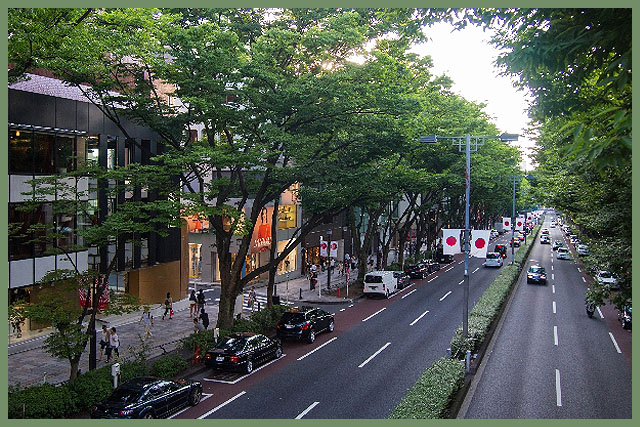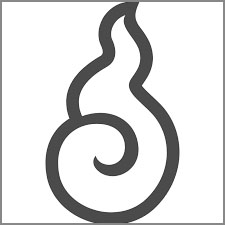https://edoflourishing.blogspot.com/2018/08/mikawa-district-kanda-chiyoda.html
.
[ . BACK to DARUMA MUSEUM TOP . ]
. Famous Places and Powerspots of Edo 江戸の名所 .
. Persons and People of Edo - Personen .
::::::::::::::::::::::::::::::::::::::::::::::::::::::::::::::::::::::::::::::::::::::::::::::::::::::::::::::::::::::::::::::::::::::::::::::::::::::::::::::::::::::::::::::::::::
Mikawa choo 三河町 Mikawacho, Mikawa district
Chiyoda ward 千代田区 / 内神田 Uchi-Kanda first district and 神田司町2丁目 Kanda Tsukasa machi second district
and 神田美土代町の一部 part of Kanda Mitoshiro cho
神田区三河町 Kanda Mikawa cho was a rather long and thin district in the Edo period.

The name refers to the Mikawa region (now Aichi prefecture), where Tokugawa Ieyasu was born.
When he came to Edo in 1590, he had his 下級武士 junior Samurai retainers settle in this district.
It is one of the old districts in Edo.
In the Meiji period it got the name of 神田区三河町 Kanda Mikawa cho.
In 1953, the first sub-district became 鎌倉町 Kamakura machi, the second to fourth sub-district were merged to
神田司町 Kanda Tsukasa machi and the old name was lost.
. Tokugawa Ieyasu 徳川家康 (1543 - 1616) .
. hachoo miso, hatchoo miso 八丁味噌 from the Mikawa region. .
a favorite food of Tokugawa Ieyasu.
.......................................................................

. Mikawa dolls 三河人形 .
made in the towns of Toyokawa and Toyohashi and many other places in Aichi prefecture.
::::::::::::::::::::::::::::::::::::::::::::::::::::::::::::::::::::::::::::::::::::::::::::::::::::::::::::::::::::::::::::::::::::::::::::::::::::::::::::::::::::::::::::::::::::
- quote -
Mikawa Province (三河国 Mikawa no kuni)
was an old province in the area that today forms the eastern half of Aichi Prefecture.
Its abbreviated form name was Sanshū (三州 or 参州). Mikawa bordered on Owari, Mino, Shinano, and Tōtōmi Provinces.
Mikawa is classified as one of the provinces of the Tōkaidō. Under the Engishiki classification system, Mikawa was ranked as a "superior country" (上国) and a "near country" (近国) in terms of its distance from the capital.
..... However, by the Sengoku period, the province had fragmented into many small territories largely dominated by the Matsudaira clan, and contested by the Imagawa clan to the east and the Oda clan to the west. It was united under Tokugawa Ieyasu after the power of the Imagawa had been destroyed at the Battle of Okehazama. After the creation of the Tokugawa shogunate, parts of the province were assigned as feudal domains to trusted hereditary retainers as fudai daimyōs, with large portions retained as tenryō territory administered by various hatamoto directly under the shogunate.
During the Edo period, Mikawa was the only area permitted by the shogunate to produce gunpowder, which led to its modern fireworks industry.
..... The entire territory of former Mikawa Province became part of the new Aichi Prefecture in January 1872.

Hiroshige "Mikawa" in "The Famous Scenes of the Sixty States" (六十余州名所図会),
depicting the mountainous scenery around the temple of Hokai-ji, a popular pilgrimage destination in Mikawa
- - - More in the WIKIPEDIA !
::::::::::::::::::::::::::::::::::::::::::::::::::::::::::::::::::::::::::::::::::::::::::::::::::::::::::::::::::::::::::::::::::::::::::::::::::::::::::::::::::::::::::::::::::::

The author of the famous tales of
Hanshichi Torimonocho 半七捕物帳 The Curious Casebook of Inspector Hanshichi
Okamoto Kido 岡本綺堂 (1872 - 1939)
lived in 三河町 Mikawa cho.
a Japanese author. His real name was Keiji Okamoto (岡本敬二 Okamoto Keiji). His best known work is the Shin Kabuki play Bancho Sarayashiki.
- - - More in the WIKIPEDIA !
Hanshichi was often called
Mikawa no Oyabun 三河の親分 The Boss of Mikawa
::::::::::::::::::::::::::::::::::::::::::::::::::::::::::::::::::::::::::::::::::::::::::::::::::::::::::::::::::::::::::::::::::::::::::::::::::::::::::::::::::::::::::::::::::::

- - - To join me on facebook, click the image !
:::::::::::::::::::::::::::::::::::::::::::::::::::::::::::::::::::::::::::::::::::::::::::::::::::::::::::::::::::::::::::::::::::::::::::::::::::::::::::::::::::::::::::::::::::::
. Chiyoda ku 千代田区 Chiyoda ward - "Fields of Eternity" .
. Kanda 神田 Kanda district .
. Edo bakufu 江戸幕府 The Edo Government .
. Famous Places and Powerspots of Edo 江戸の名所 .
. Doing Business in Edo - 商売 - Introduction .
. shokunin 職人 craftsman, craftsmen, artisan, Handwerker .
. senryu, senryū 川柳 Senryu poems in Edo .
. Japanese Architecture - The Japanese Home .
. Interior Design - The Japanese Home .
. Legends and Tales from Japan 伝説 - Introduction .
[ . BACK to DARUMA MUSEUM TOP . ]
[ . BACK to WORLDKIGO . TOP . ]
- - - - - ##mikawa #kandamikawa #mikawadistrict #hanshichi - - - -
::::::::::::::::::::::::::::::::::::::::::::::::::::::::::::::::::::::::::::::::::::::::::::::::::::::::::::::::::::::::::::::::::::::::::::::::::::::::::::::::::::::::::::::::::::
.
Mikawa district Kanda Chiyoda
. Famous Places and Powerspots of Edo 江戸の名所 .
. Persons and People of Edo - Personen .
::::::::::::::::::::::::::::::::::::::::::::::::::::::::::::::::::::::::::::::::::::::::::::::::::::::::::::::::::::::::::::::::::::::::::::::::::::::::::::::::::::::::::::::::::::
Mikawa choo 三河町 Mikawacho, Mikawa district
Chiyoda ward 千代田区 / 内神田 Uchi-Kanda first district and 神田司町2丁目 Kanda Tsukasa machi second district
and 神田美土代町の一部 part of Kanda Mitoshiro cho
神田区三河町 Kanda Mikawa cho was a rather long and thin district in the Edo period.

The name refers to the Mikawa region (now Aichi prefecture), where Tokugawa Ieyasu was born.
When he came to Edo in 1590, he had his 下級武士 junior Samurai retainers settle in this district.
It is one of the old districts in Edo.
In the Meiji period it got the name of 神田区三河町 Kanda Mikawa cho.
In 1953, the first sub-district became 鎌倉町 Kamakura machi, the second to fourth sub-district were merged to
神田司町 Kanda Tsukasa machi and the old name was lost.
. Tokugawa Ieyasu 徳川家康 (1543 - 1616) .
. hachoo miso, hatchoo miso 八丁味噌 from the Mikawa region. .
a favorite food of Tokugawa Ieyasu.
.......................................................................

. Mikawa dolls 三河人形 .
made in the towns of Toyokawa and Toyohashi and many other places in Aichi prefecture.
::::::::::::::::::::::::::::::::::::::::::::::::::::::::::::::::::::::::::::::::::::::::::::::::::::::::::::::::::::::::::::::::::::::::::::::::::::::::::::::::::::::::::::::::::::
- quote -
Mikawa Province (三河国 Mikawa no kuni)
was an old province in the area that today forms the eastern half of Aichi Prefecture.
Its abbreviated form name was Sanshū (三州 or 参州). Mikawa bordered on Owari, Mino, Shinano, and Tōtōmi Provinces.
Mikawa is classified as one of the provinces of the Tōkaidō. Under the Engishiki classification system, Mikawa was ranked as a "superior country" (上国) and a "near country" (近国) in terms of its distance from the capital.
..... However, by the Sengoku period, the province had fragmented into many small territories largely dominated by the Matsudaira clan, and contested by the Imagawa clan to the east and the Oda clan to the west. It was united under Tokugawa Ieyasu after the power of the Imagawa had been destroyed at the Battle of Okehazama. After the creation of the Tokugawa shogunate, parts of the province were assigned as feudal domains to trusted hereditary retainers as fudai daimyōs, with large portions retained as tenryō territory administered by various hatamoto directly under the shogunate.
During the Edo period, Mikawa was the only area permitted by the shogunate to produce gunpowder, which led to its modern fireworks industry.
..... The entire territory of former Mikawa Province became part of the new Aichi Prefecture in January 1872.

Hiroshige "Mikawa" in "The Famous Scenes of the Sixty States" (六十余州名所図会),
depicting the mountainous scenery around the temple of Hokai-ji, a popular pilgrimage destination in Mikawa
- - - More in the WIKIPEDIA !
::::::::::::::::::::::::::::::::::::::::::::::::::::::::::::::::::::::::::::::::::::::::::::::::::::::::::::::::::::::::::::::::::::::::::::::::::::::::::::::::::::::::::::::::::::

The author of the famous tales of
Hanshichi Torimonocho 半七捕物帳 The Curious Casebook of Inspector Hanshichi
Okamoto Kido 岡本綺堂 (1872 - 1939)
lived in 三河町 Mikawa cho.
a Japanese author. His real name was Keiji Okamoto (岡本敬二 Okamoto Keiji). His best known work is the Shin Kabuki play Bancho Sarayashiki.
- - - More in the WIKIPEDIA !
Hanshichi was often called
Mikawa no Oyabun 三河の親分 The Boss of Mikawa
::::::::::::::::::::::::::::::::::::::::::::::::::::::::::::::::::::::::::::::::::::::::::::::::::::::::::::::::::::::::::::::::::::::::::::::::::::::::::::::::::::::::::::::::::::

- - - To join me on facebook, click the image !
:::::::::::::::::::::::::::::::::::::::::::::::::::::::::::::::::::::::::::::::::::::::::::::::::::::::::::::::::::::::::::::::::::::::::::::::::::::::::::::::::::::::::::::::::::::
. Chiyoda ku 千代田区 Chiyoda ward - "Fields of Eternity" .
. Kanda 神田 Kanda district .
. Edo bakufu 江戸幕府 The Edo Government .
. Famous Places and Powerspots of Edo 江戸の名所 .
. Doing Business in Edo - 商売 - Introduction .
. shokunin 職人 craftsman, craftsmen, artisan, Handwerker .
. senryu, senryū 川柳 Senryu poems in Edo .
. Japanese Architecture - The Japanese Home .
. Interior Design - The Japanese Home .
. Legends and Tales from Japan 伝説 - Introduction .
[ . BACK to DARUMA MUSEUM TOP . ]
[ . BACK to WORLDKIGO . TOP . ]
- - - - - ##mikawa #kandamikawa #mikawadistrict #hanshichi - - - -
::::::::::::::::::::::::::::::::::::::::::::::::::::::::::::::::::::::::::::::::::::::::::::::::::::::::::::::::::::::::::::::::::::::::::::::::::::::::::::::::::::::::::::::::::::




































